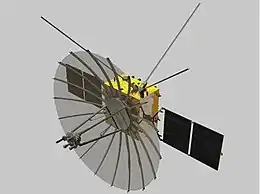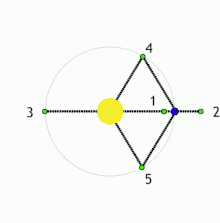Queqiao relay satellite
Queqiao relay satellite (Chinese: 鹊桥号中继卫星; pinyin: Quèqiáo hào zhōngjì wèixīng; lit. 'Magpie Bridge relay satellite'), also known as the Chang'e 4 Relay, is a communications relay and radio astronomy satellite for the Chang'e 4 lunar farside mission. As part of the Chinese Lunar Exploration Program, the China National Space Administration (CNSA) launched the Queqiao relay satellite on 20 May 2018 to a halo orbit around the Earth–Moon L2 Lagrangian point[4][5] Queqiao is the first ever communication relay and radio astronomy satellite at this location.[3]
 Rendering of Queqiao satellite | |
| Mission type | Communication relay Radio astronomy |
|---|---|
| Operator | CNSA |
| COSPAR ID | 2018-045A |
| SATCAT no. | 43470 |
| Mission duration | Planned: 5 years 5 years, 4 months, 29 days (in progress) |
| Spacecraft properties | |
| Bus | CAST100[1] |
| Manufacturer | DFH Satellite Company LTD |
| Launch mass | 448.7 kilograms (989 lb)[1] |
| Dry mass | 325 kilograms (717 lb) |
| Dimensions | Satellite: 1.4 × 1.4 × 0.85 m[1] Antenna: 4.2 metres (14 ft) in diameter[1] |
| Power | 800W[1] |
| Start of mission | |
| Launch date | 20 May 2018 21:28 UTC[2] |
| Rocket | Long March 4C[2] |
| Launch site | Xichang Satellite Launch Center LC-3[2] |
| Orbital parameters | |
| Reference system | Halo orbit |
| Earth-Moon L2 point orbiter | |
| Orbital insertion | 14 June 2018[3] |
The name Queqiao ("Magpie Bridge") was inspired by and came from the Chinese tale The Cowherd and the Weaver Girl.[4]
Design and development


Queqiao was designed to function as a communication relay for the Chang'e 4 mission to the far side of the Moon, as well as a deep space radio astronomy observatory for the Chinese space program.[4][6][7]
Direct communication with Earth is impossible on the far side of the Moon, since transmissions are blocked by the Moon. Communications must go through a communications relay satellite, which is placed at a location that has a clear view of both the landing site and the Earth. A circular orbit, while easy to achieve, would periodically carry the satellite out of sight of either the lander or the Earth. A constellation of multiple satellites can solve this problem at the cost of greater expense and risk. With this in mind, placing a satellite in orbit not around the Moon itself, but around an equilibrium point of the Earth-Moon system on the far side of the Moon (L2) becomes an attractive option.[8]
The types of orbits near the equilibrium points, include Lyapunov orbits, halo orbits, Lissajous orbits, and quasi-halo orbits. Lyapunov orbits pass behind the Moon, restricting communication opportunities with Earth for long periods of time, and as such were not considered. Lissajous orbits require less stationkeeping than halo orbits, but suffer from occasionally passing behind the Moon as well. Their non-periodicity–a trait shared with quasi-halo orbits–further complicates maintaining the pointing of antennas and solar arrays. Thus a halo orbit was chosen, at the cost of greater stationkeeping expense.[8]
An L2 halo orbit as a communications relay for an Apollo mission to the far side of the Moon was first suggested in 1966 by Robert W. Farquhar.[9] In the end, no relay satellite was launched for Apollo.[10] Although a number of spacecraft have operated in halo orbits in the Earth-Sun system since then,[11] China was the first to realize Farquhar's original idea of a communications relay satellite in a halo orbit around the Earth-Moon L2 point.[12]
The satellite is based on the Chang'e 2 design.[13] It utilizes the CAST100 small satellite bus with an aluminum honeycomb sandwich plate structure, and several 3D-printed parts.[1]
Communication with the lunar surface is accomplished in the X band, using a high-gain 4.2 metres (14 ft) deployable parabolic antenna, the largest antenna used for a deep space exploration satellite.[14] The lunar link uses PCM/PSK/PM modulation in the forward link and BPSK in the backward link. The forward link data rate of the lander and the rover is 125 bit/s. The return link data rate is up to 555 kbit/s for the lander and up to 285 kbit/s for the rover. Data transmission to the Earth operates in the S band in BPSK modulation mode, using a single mid-gain helix antenna at a data rate of up to 10 Mbit/s.[1][15]
Mission

On 20 May 2018, several months before the Chang'e 4 mission, the Queqiao was launched from Xichang Satellite Launch Center in China, on a Long March 4C rocket.[2] The spacecraft took 24 days to reach L2, using a gravity assist at the Moon to save propellant.[3] On 14 June 2018, Queqiao finished its final adjustment burn and entered the mission orbit, about 65,000 kilometres (40,000 mi) from the Moon. This is the first lunar relay satellite ever placed in this location.[3]
In addition to its communication relay equipment, Queqiao carries the Netherlands-China Low Frequency Explorer (NCLE), a radio-astronomy experiment to detect faint radio signals from the early universe.[16] The instrument is intended to perform a wide range of observations in the low-frequency radio regime, such as studying space weather and characterizing the radio background environment at L2. The far side of the Moon is an ideal environment for radio astronomy, because the Moon can shield instruments from man-made radio frequency interference coming from the Earth. While Queqiao's primary mission will keep the instrument constantly in line of sight of the Earth, and expose it to radio interference from the primary communication relay hardware, the accumulated experience and data from NLCE will serve as a pathfinder for future deep space radio astronomy instruments.[5] NLCE successfully deployed its antennas on 27 November 2019.[17]
Queqiao is additionally fitted with a laser reflector developed by Sun Yat-sen University as a pilot study for the TianQin gravitational-wave observatory project.[18]
A pair of scientific microsatellites, Longjiang-1 and Longjiang-2, has been launched with the Queqiao as a secondary payload. The microsatellites weigh 45 kg each and measure 50x50x40 centimeters.[19] Developed at the Harbin Institute of Technology, the microsatellites were to fly in formation in a 300x3000 km orbit to perform ultra-long-wavelength astronomical interferometry.[20] Contact was lost with Longjiang-1 shortly after trans-lunar injection, but Longjiang-2 successfully entered a 350x13700 km altitude lunar orbit on 25 May. Longjiang-2 was equipped with a micro-optical camera provided by King Abdulaziz City for Science and Technology, returning color images of the Earth and the lunar surface.[19] On 24 January 2019, Longjiang-2 performed an end-of-mission maneuver, lowering its periapsis to 500 km. The orbit gradually decayed due to gravitational perturbations with the microsatellite impacting the far side of the lunar surface at 14:20 UTC, 31 July 2019.[20]
International collaboration
China and Radboud University of Netherland collaborated on the Netherlands-China Low Frequency Explorer (NCLE), a radio-astronomy experiment.[17] China has also agreed to a request from NASA to use the Chang'e 4 probe and Queqiao relay satellite in future U.S. Moon missions.[21]
Further development
Queqiao-2 is expected to be launched in 2024, supporting China's Chang'e 6, 7 and 8 lunar missions. The upgraded Queqiao-2 relay would use a elliptical frozen orbit of 300 km × 8600 km with an inclination of 54.8°,[22] instead of the L2 halo orbit.[23] Queqiao-2 will also carry two smaller communication satellites, Tiandu-1 and Tiandu-2, to verify the technicality of the lunar communication and navigation constellation based on the Queqiao technology.[24]
References
- Zhang, LiHua; Xiong, Liang; Sun, Ji; Gao, Shan; Wang, XiaoLei; Zhang, AiBing (2019-02-14). "Technical characteristics of the relay communication satellite "Queqiao" for Chang'e-4 lunar farside exploration mission". Scientia Sinica Technologica (in Chinese). 49 (2): 138–146. doi:10.1360/N092018-00375. ISSN 2095-946X. S2CID 88483165.
- Barbosa, Rui; Bergin, Chris (2018-05-20). "Queqiao relay satellite launched ahead of Chang'e-4 lunar mission". NASASpaceFlight.com. Archived from the original on 2020-11-09. Retrieved 2021-10-17.
- Xu, Luyuan (15 June 2018). "How China's lunar relay satellite arrived in its final orbit". The Planetary Society. Archived from the original on 17 October 2018.
- Wall, Mike (18 May 2018). "China Launching Relay Satellite Toward Moon's Far Side Sunday". Space.com. Archived from the original on 18 May 2018.
- "Queqiao". NASA.
- Emily Lakdawalla (14 January 2016). "Updates on China's lunar missions". The Planetary Society. Archived from the original on 17 April 2016. Retrieved 24 April 2016.
- Jones, Andrew (24 April 2018). "Chang'e-4 lunar far side satellite named 'magpie bridge' from folklore tale of lovers crossing the Milky Way". GBTimes. Archived from the original on 24 April 2018. Retrieved 28 April 2018.
- Wu, Weiren; Tang, Yuhua; Zhang, Lihua; Qiao, Dong (2017-12-12). "Design of communication relay mission for supporting lunar-farside soft landing". Science China Information Sciences. 61 (4): 040305. doi:10.1007/s11432-017-9202-1. ISSN 1869-1919. S2CID 22442636.
- Robert Farquhar (1966). "Station-Keeping in the Vicinity of Collinear Libration Points with an Application to a Lunar Communications Problem". AAS Science and Technology Series: Space Flight Mechanics Specialist Symposium. 11: 519–535., see Farquhar, R. W.: "The Control and Use of Libration-Point Satellites", Ph.D. Dissertation, Dept. of Aeronautics and Astronautics, Stanford University, Stanford, California, 1968, pp. 103, 107–108.
- Schmid, P. E. (June 1968). "Lunar Far-Side Communication Satellites" (PDF). NASA. Retrieved 2008-07-16.
- Dunham, D.W. and Farquhar, R. W.: "Libration-Point Missions 1978-2000," Libration Point Orbits and Applications, Parador d'Aiguablava, Girona, Spain, June 2002
- Xu, Luyuan (2018-06-15). "How China's lunar relay satellite arrived in its final orbit". The Planetary Society.
This is the first-ever lunar relay satellite at this location.
- Future Chinese Lunar Missions: Chang'e 4 - Farside Lander and Rover. David R. Williams, NASA Goddard Space Flight Center. 7 December 2018.
- "鹊桥号发射成功 将成为世界首颗连通地月中继卫星". 2018-05-21. Archived from the original on 2018-05-27. Retrieved 2018-05-26.
- Chang'e 4 relay satellite, Queqiao: A bridge between Earth and the mysterious lunar farside Archived 21 May 2018 at the Wayback Machine. Xu, Luyan, The Planetary Society. 19 May 2018. Retrieved on 20 May 2018
- Vecchio, Antonio; Bentum, Mark; Falcke, Heino; Boonstra, Albert-Jan; Ping, Jinsong; Chen, Linjie; Klein-Wolt, Marc; Brinkerink, Christiaan; Rotteveel, Jeroen; Pourshaghaghi, Hamid; Karapakula, Sukanth (2021-01-01). "The Netherlands-China Low-frequency explorer (NCLE)". 43rd Cospar Scientific Assembly. Held 28 January - 4 February. 43: 1525. Bibcode:2021cosp...43E1525V.
- Bartels, Meghan (2 December 2019). "Radio Telescope Unfurls 3 Antennas Beyond the Far Side of the Moon". Space.com.
- Lsquirrel (2018-05-20). "鹊桥号启程,为嫦娥四号登陆月球背面架设通信桥梁". 果壳网. Archived from the original on 2019-01-04. Retrieved 2019-01-04.
- "Chinese satellite snags new views of Earth from lunar orbit". The Planetary Society. Retrieved 2021-10-17.
- "Lunar Orbiter Longjiang-2 Smashes into Moon". The Planetary Society. Retrieved 2021-10-17.
- Needham, Kirsty (19 January 2019). "Red moon rising: China's mission to the far side". The Sydney Morning Herald.
- Lihua Zhang (2021-07-21). "Development and Prospect of Chinese Lunar Relay Communication Satellite". Space: Science & Technology. 2021. Bibcode:2021SpScT202171608Z. doi:10.34133/2021/3471608. S2CID 235211533. Retrieved 2023-08-24.
- Jones, Andrew (23 January 2023). "China to launch relay satellite next year to support moon landing missions". SpaceNews.
- Jones, Andrew (10 May 2023). "China to launch communications relay satellite to the moon in early 2024". Space.com.

